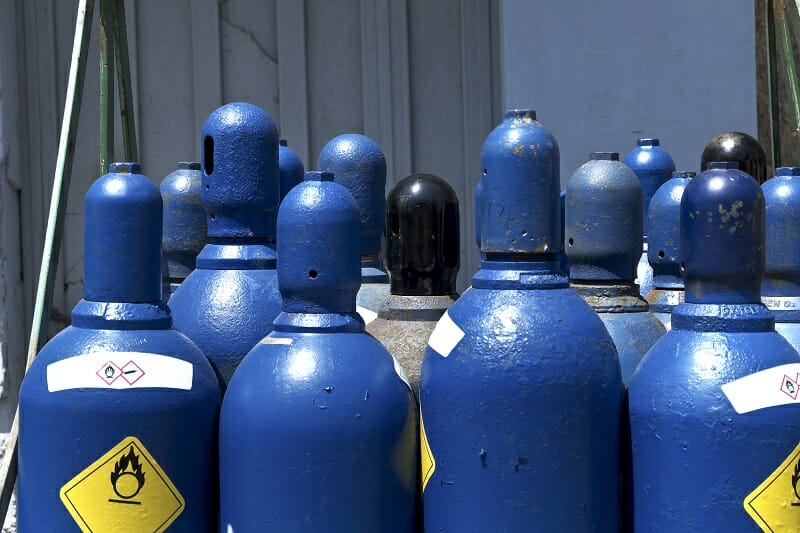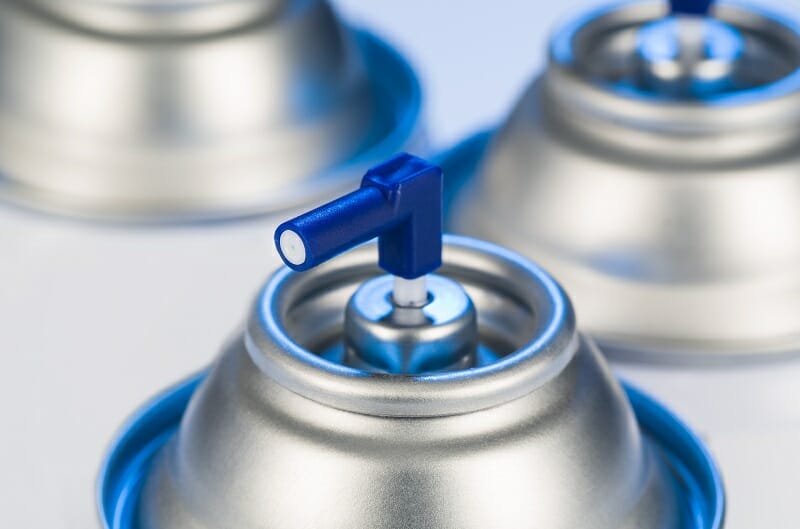What Is an Inhalant Drug?
Inhalant drugs are substances found in solvents, aerosols, gases and nitrates. (1) When inhaled, these chemicals induce mind-altering effects. There are many types of inhalants, including gasoline, paint, glue, household cleaners, nitrous oxide and even hairspray and whipped cream. The exact side effects of inhalants vary depending on the type used.
Inhalant drug use is particularly prevalent among young people simply because these substances are easier to obtain than most other drugs. Experimentation with inhalants is common among middle school and high school students. This is especially true when it comes to common household chemicals that can be easily obtained without detection.
Although inhalants are considered an introductory drug that may lead to experimentation with or use of other substances, that doesn’t negate the dangers associated with abuse of inhalant drugs. Abuse can lead to serious long-term side effects, including brain damage, organ failure, coma and even instant death.
Classification by Function, Effect or Chemical Structure
Inhalants are identified by several classifications. (2) These include chemical, function and pharmacological properties or effect.
Chemical classification is based on the chemical structure of the drug. Chemical types are categorized as either volatile nitrates, gases and propellants, solvents or aerosols. While it’s not been proven that the chemical structure of inhalants has any effect on their addictive properties, users do typically prefer inhaling volatile nitrates over other forms of inhalant drugs.
When classifying inhalants by function, they’re categorized by their intended use. (3) These categories include household cleaners and products such as degreasers, cleaners, laundry detergent, pesticides and paint and paint thinners, as well as medical gases and commercial chemicals.
Each type of inhalant has the potential to produce different effects, just as each user reacts to these chemicals in a different way. Most inhalants work by slowing down brain activity; (4) however, nitrates have a different effect on the brain. They expand and relax the brain’s blood vessels. Regardless of the pharmacological properties of any particular inhalant, long-term use consistently damages brain cells and nerve fibres.
The four general classifications of inhalants are:
- Volatile Solvents: Liquids that vaporize at room temperature, which include typical household products such as degreasers, correction fluid, felt-tip markers and glue
- Aerosols: Sprays containing solvents including spray paints, whipped cream canisters, vegetable oil spray and hairspray
- Gases: Medical aesthetics and industrial products such as chloroform, halothane and nitrous oxide
- Nitrites: Also known as poppers, this classification includes cyclohexyl nitrite, isoamyl and isobutyl nitrite

Routes of Inhalants Administration
Inhalants are breathed in through either the nose or the mouth. (5) This can be done in a number of ways.
- Sniffing/Snorting: Smelling or inhaling fumes directly from the containers they’re stored in
- Spraying: Users spray chemicals or fumes directly into their nose or mouth
- Bagging: Placing substances in a plastic or paper bag and inhaling fumes with the bag placed over the nose and mouth
- Huffing: Soaking a rag in an inhalant drug and placing it in the mouth while breathing deeply
- Ballooning: Filling balloons with nitrous oxide and inhaling the substance from the opening
Each method of administration carries its own risks, in addition to the consumption of the chemical substance, which will be discussed later on. Bagging, ballooning and huffing all come with a high risk of suffocation and asphyxiation, while sniffing, snorting and spraying can lead to chemical burns, choking, nausea, vomiting and severe nosebleeds.
What Are the Different Forms of Inhalants?
Inhalants come in many forms. Any chemical that produces mind-altering side effects when inhaled is considered a type of inhalant drug. They can be found in ordinary household products, industrial settings and even medical offices. The most commonly used forms of inhalants included spray paints and glue, nitrous oxide and poppers (amyl nitrite and butyl nitrite).
Spray paints and glue
Inhaling spray paints and glue (6) is one of the most common forms of inhalants abuse. It can be ingested by huffing, bagging, sniffing, snorting or spraying, although huffing is the most common method of administration. In spray paint and glue, the chemical that produces a high is called toluene. It’s a toxic chemical that absorbs into the bloodstream quickly through the lungs and causes temporary euphoria, which is typically accompanied by dizziness, loss of inhibition, slurred speech and drowsiness.
Poppers
Poppers, which are a type of inhalant drug containing either amyl nitrate or butyl nitrate, produce an immediate high. (7) They’re sometimes sold under the pretence of being leather cleaners or room deodorizers; however, most people who purchase the drug are aware of its actual purpose and rarely, if ever, use it for the purpose stated on the label. Poppers induce an immediate drop in blood pressure, warmth, increased heart rate and relaxed anal muscles, which some say increases sexual pleasure.

Nitrous oxide
Nitrous oxide is classified as a gas. (1) It’s a medical anaesthetic that is often used in dental offices and hospitals. It’s more commonly known as laughing gas because of its tendency to induce laughter and decreased inhibitions in those who use it. It’s often offered to labouring mothers as it can help to decrease pain during contractions.
Nitrous oxide is a colourless and odourless substance, and in addition to its use in medical applications, it’s commonly used in aerosol sprays such as hairspray and whipped cream.
When inhaled, it produces a temporary sedative effect. Its effects wear off in mere seconds, which makes the risk of overdose high in those who attempt to maintain the feeling it induces.
Call our admissions line 24 hours a day to get help.
What Are the Common Street Names of Abused Inhalants?
Inhalants go by many names. While some abusers may simply call the drug by its chemical or manufactured name, there are a range of other words that can be used to describe inhalant drugs. It’s vital that parents, in particular, familiarize themselves with these terms, as these words are common among children and teenagers who are using inhalants recreationally.
Depending on the type of inhalant, it might be referred to by any one of the following names:
- Air blast
- Ames
- Amys
- Aroma of men
- Bolt
- Boppers
- Bullet
- Bullet bolt
- Buzz bomb
- Discorama
- Hardware
- Heart-on
- Hiagra in a bottle
- Highball
- Hippie crack
- Huff
- Laughing gas
- Locker room
- Medusa
- Moon gas
- Oz
- Pearls
- Poor man’s pot
- Poppers
- Quicksilver
- Rush snappers
- Satan’s secret
- Shoot the breeze
- Snappers
- Snotballs
- Spray
- Texas shoeshine
- Thrust
- Toilet water
- Toncho
- Whippets
- Whiteout
How Dangerous Are Inhalants?
Inhalants are incredibly dangerous. They can produce long-term health problems with only one use. (8) Inhaling any dangerous chemical is just as harmful as eating or drinking the substance, and while the immediate effects may be slightly different, the long-term effects can be very similar.
Inhalant drugs can weaken the immune system and make users more susceptible to contracting diseases ranging from the common cold to meningitis. Additionally, continued use can cause severe damage to various organs, including the heart, lungs, bone marrow, liver, kidneys and even the brain. When it comes to the brain, long-term use of inhalant drugs can permanently decrease its ability to obtain sufficient oxygen, leading to hearing and vision loss, seizures and depletion of brain tissue.
With even one use, inhalant users can black out. A blackout is defined as a short period of time during which the user is unconscious or has no memory of events. In extreme cases, the user may end up in a coma.
Sudden sniffing death syndrome
Sudden sniffing death syndrome (9) is a very real danger for those who use inhalants, even just once. This occurs when the user dies immediately after inhaling chemicals and may occur as a result of tachycardia (dramatically increased heart rate) or from the chemicals blocking the airways and suffocating the user.
Death can occur as a result of inhalant abuse in several other ways:
- Asphyxiation, which occurs when chemicals dominate airspace in the lungs, leaving little to no room for oxygen
- Suffocation from plastic bags placed over the head or mouth
- Seizure
- Choking on vomit while passed out
Who Abuses Inhalants?
In addition to children and young adults, inhalant abuse is common among those living below the poverty line. Inhalants are less expensive and more accessible than most other drugs, which is likely the reason they’re widely abused within these communities.

In countries such as Pakistan and Nairobi, inhalant abuse is at epidemic levels among street children. (10) In Karachi, Pakistan, an estimated 80% to 90% of street kids use inhalants, while in Nairobi, of an estimated 60,000 children who live on the streets, nearly 100% are addicted to inhalants.
Risk Factors
The risk factors (11) for abusing inhalants and other substance abuse problems are similar and include a variety of social, environmental and genetic causes.
Social and environmental
- Community: When children and adolescents grow up in a community in which inhalant abuse is prevalent, their risk for use increases dramatically.
- Educational Issues: A person who performs poorly in school or drops out of school has a higher risk of using inhalants and other drugs.
- Family Dysfunction: Children from unhealthy environments have a high risk of drug abuse and alcoholism.
- Peer Pressure: Youth who see their friends or others at school abusing inhalants are more likely to engage.
- Alienation: Many young inhalant users have smaller circles of friends or tend to be unpopular in school.
- Criminal Behaviour: The link between drug abuse and criminal behaviour is strong; in particular, adolescents who have spent time in jail or detention centres have a substantially higher risk of using inhalants and other drugs.
- Economic Status: People who live in poverty-stricken areas are more likely to abuse inhalants than other drugs.
The availability and low cost of inhalants is known to lead to high instances of abuse in those who fall into the above categories.

Genetic
There is a genetic risk factor for all addictions. When it comes to inhalants, those whose parents or other immediate family members have struggled with alcohol addiction or other substance dependence issues are far more at risk to develop addiction problems throughout their lifetime. Those who are genetically predisposed to addiction issues and abuse inhalants, either as the result of peer pressure or what they feel is necessity, run the highest risk of addiction.
Inhalants Abuse: Signs & Symptoms
If you suspect that someone you know may be abusing inhalants, there are several signs you can watch for. While many of these symptoms are only present for a short time after the person uses the drug, some of these, including facial rashes and odours, may be present for some time after use.
- Slurred speech
- Jerky reactions
- Mild highs
- A general loss of motor control
- Users will look like they’re drunk
- Nausea and vomiting
- Sedation
- Hallucination
- Dilated pupils
- Loss of appetite
- Facial rash where the inhalant blistered the skin
- Chemical-like smell that reminds you of fresh paint
- Marks around their mouth and noses, particularly if they’re sniffing paint
If your teen or someone else you know is exhibiting these symptoms, it’s best to address the situation immediately. Inhalant abuse can cause death in just one dose; therefore, it’s crucial to seek help as quickly as possible. For families who are overwhelmed and need help addressing the issue, UKAT’s professional intervention services may be the best option.
Why Are Inhalants So Addictive?
Although inhalants aren’t instantly addictive, (4) they do have the potential to cause a substance use disorder with continued use. Inhalants are a psychoactive drug that changes the chemistry of the user’s brain, so when someone uses this drug on a regular basis, they’ll find themselves increasingly dependent on the drug to maintain the state that their brain has become used to.
When a person who is physically dependent on inhalants ceases use, they may experience any or all of the following withdrawal symptoms:
- Nausea and vomiting
- Hand tremors
- Decreased appetite
- Chills/sweating
- Insomnia
- Mood changes
- Hallucinations
- Delusions
Inhalants can also create a behavioural or psychological addiction, which means the user is not necessarily addicted to the drug itself but to the action of using it and the state of euphoria it causes. While a behavioural addiction doesn’t produce withdrawal symptoms when use is discontinued, it is still a serious addiction that usually requires treatment.
As a person becomes behaviourally addicted to a drug like inhalants, they often find that the cravings for the drug become more frequent and increasingly strong. Many will find themselves participating in drug-seeking behaviours and criminal activity to obtain more of the inhalants that they’re most addicted to using.
In most cases, users who are physically dependent on inhalant drugs are also psychologically addicted. When this happens, it’s usually necessary to enter a medically supervised detoxification programme that’s accompanied by counselling and group therapy.
Teen Inhalant Abuse
As mentioned earlier, teens are the highest risk group when it comes to inhalant abuse. In both the US and the UK, use is most common among high school students and those in middle school. The most common age of users is between 12 and 17 years old, with 14-year-olds representing the largest portion of teen users. (12)
According to the National Institute on Drug Abuse, (13) users aged 12 to 15 are most commonly abusing inhalant drugs such as glue, paint, lighter fluid and gasoline, while those aged 16 to 17 are more common users of nitrous oxide. While poppers are most common among adults, some teens have been known to experiment with and get addicted to this form of the drug.
Ways to tell your teen is abusing inhalants
Unfortunately, since many forms of inhalants can be found in and around the home, identifying abuse in your teen isn’t as simple as finding a stash in their bedroom. Inhalants are common in every household and can be found in everyday products, including paint, whipped cream, hairspray, vegetable spray and even spray deodorant. If you suspect that your teen might be abusing inhalants such as these, you can monitor them for some of the following signs:
- Slurred speech
- Sores or small spots around the mouth
- Chapped lips or chapped skin around the mouth and nose
- An odd smell on their breath
- Loss of appetite
- Disorientation
- Nausea
- Red, watery eyes
- Nasal congestion or runny nose
While many solvents, aerosols and gases are found in products commonly used around the house, there are some youth who choose to inhale nitrates, otherwise known as poppers. This type of inhalant drug is typically used to enhance sexual pleasure. When purchased for recreational use, it’s usually in small brown bottles and may be labelled as one of the following:
- Room deodorizer
- Leather cleaner
- Liquid aroma
- Video head cleaner
Teens who are abusing inhalants may also become increasingly moody and secretive. Parents who are suspicious that their child may be abusing inhalants may wish to check their child’s room for the following common household substances:
- Household cleaners
- Gasoline
- Felt-tip markers
- Spray paint
- Shoe polish
- Paint thinner
- Butane lighter fluid
- Rubber cement or glue
- Correction fluid
- Cooking spray
- Spray deodorant
- Hairspray
- Nail polish remover
Although some of these substances may seem to be commonplace in any teenager’s room, the presence of one of these substances in their bedroom when it’s not expected, or the presence of empty containers or multiple containers, should at least warrant a discussion about inhalant drug abuse.
The Long-Term Side Effects of Inhalant Abuse
Chronic inhalant use leads to a variety of severe and permanent side effects. While the use of glue and paint thinner has been known to cause problems in the kidneys, other inhalant drugs, including solvents, have the potential to cause serious liver damage. Most users of inhalant drugs also experience long-term memory damage, diminished intelligence and disorganized thoughts.
Other long-term side effects of inhalant abuse often include:
- Brain damage
- Muscle weakness
- Depression
- Loss of sensation
- Severe nosebleeds
- Death
Each type of inhalant has its own long-term health risks associated with it, as well.
- Poppers or Nitrites: These can weaken the immune system and may lead to injured blood cells and long-term heart problems.
- Benzene: This chemical is found in gasoline and can cause a reduction in bone marrow, weaken the immune system and lead to reproductive issues.
- Butane or Propane: These are found in lighter fluid and hairspray, and they can cause chemical burns and heart problems.
- Freon: Freon is found in aerosol sprays. It can cause respiratory and cardiovascular problems, as well as liver damage.
- Methylene Chloride: This chemical is present in degreasers and paint thinners. It can cause blood cell damage and heart problems.
- Nitrous Oxide or Hexane: These chemicals can cause immediate oxygen deprivation that leads to spasms, blackouts, heart problems and sensation loss.
- Toluene: Present in gasoline, glue, paint and correction fluid, this chemical can lead to permanent brain damage, motor skill problems, kidney damage and liver damage.
- Trichloroethylene: A chemical that’s found in degreasers and fabric cleaners, trichloroethylene can cause cirrhosis of the liver, heart problems and reproductive damage.
The Effects of Inhalant Abuse on the Human Nervous System
Inhalants are particularly dangerous to the body’s central nervous system, which is controlled by the brain. Inhaling chemicals changes the brain’s chemistry and can lead to permanent, irreversible brain damage and loss of motor, memory and nerve function.

- Euphoria
- Dizziness
- Disorientation
- Slurred speech
- Light-headedness
- Delusions
- Hallucinations
These effects can take place for a period of only minutes and are usually followed by drowsiness and headache. Although these effects last only a few minutes, the chemicals can remain in the brain for much longer. (15) They’re absorbed by the brain’s fatty tissues, including myelin, which is the fatty tissue that protects the brain’s nerve cells. Over time, repeated inhalant abuse can break down myelin, leaving nerve cells exposed and unable to properly transmit signals to the rest of the body.
When myelin breaks down and nerve cells are unable to operate effectively, the long-term effects can vary depending on the part of the brain this occurs in. When inhalants affect the cerebellum, the user may find themselves unable to control motor function properly. When they affect the frontal cortex, users may struggle with planning, decision making and impulse control. And when they affect the hippocampus, which controls memory, the user may find that they’re unable to learn new things, keep track of conversations or remember important facts or events.
One exception to the above is nitrites, which don’t work in the same way as other inhalants. While nitrates, or poppers as they’re commonly known, do change the brain’s chemistry, their effects are slightly different. They expand blood vessels in the brain, which can cause blood pressure problems, fainting, coma, headaches, respiratory problems and intraocular pressure.
The Social Effect of Inhalant Abuse
Just as with any other drug, inhalant abuse has great consequences not only on the user but on society as a whole. (16) It does great damage to public safety, crime and the healthcare system, the costs of which are, in most cases, immeasurable. The drug overdoses and health problems incurred by inhalant abusers alone cost national governments around the world billions of pounds, and those who participate in the illegal distribution of nitrates and other chemicals have a similar effect on the justice system. Additionally, governments invest millions of pounds in awareness campaigns and other prevention efforts each year.
Inhalant abuse also affects public safety. Some users have a tendency to turn to crimes such as theft and robbery when they aren’t able to afford the chemicals they prefer to use. Additionally, many individuals who abuse inhalant drugs may turn violent while under the influence. This reaction negatively affects anyone in the presence of a person abusing inhalants and in some cases can be costly and time consuming for local organizations, including Her Majesty’s Prison Forces and police officers who must carry out punishment after crimes and violent behaviour occurs.
Inhalant abuse can also be detrimental to overall productivity. Workers who abuse inhalant drugs are often unreliable as employees and may frequently call in sick or perform poorly on the job. Those who are school aged are often less successful in their studies and may drop out of school.
Call our admissions line 24 hours a day to get help.
Inhalant Abuse Statistics and Trends
Inhalant abuse is rampant among teens and young adults, and the problem is a global one. The statistics that follow are representative of the problem this drug has caused in communities around the world.
- In the UK, an estimated 7.6% of secondary school kids have tried inhalants at least once. (17)
- Scotland, Northern Ireland and East England have the highest inhalant mortality rates in the UK. (17)
- An average of 45 people in the UK die from inhalant abuse each year. (17)
- In the US, 1.1 million youths aged 12 to 17 have experimented with inhalants. (1)
- 22% of inhalant users who died of inhalant abuse between 2002 and 2006 were first-time users. (18)
- Inhalants are the substance that’s tried most frequently among 12- and 13-year-olds. (1)
Inhalants Addiction Treatment Options
Those who are addicted to inhalants, regardless of the type, can overcome their problem. While some require residential treatment in rehab facility, others may be able to kick their addiction with outpatient counselling or group therapy.
Treatment programmes include detoxification, counselling and aftercare, which helps the user to avoid relapse or further addictions to other substances. Detoxification is the process of cleansing the body of harmful chemicals. During detoxification, clients experience the worst of their withdrawal symptoms, including anxiety, irritability, fatigue, insomnia, tremors, nausea and vomiting. In some cases, clients may experience hallucinations or delusions. These symptoms usually occur within 24 to 48 hours of the last time the drug was used and may last several days.
Once the body has been cleansed of the drug, clients move on to a customized counselling programme that’s designed to meet their specific needs and the nature of their addiction. These programmes include behavioural therapy, one-on-one counselling and group therapy, followed by aftercare that may include completion of a 12-step program and continued counselling or group therapy.

Medications That May Help Your Addiction Recovery Efforts
While there aren’t any medications that are specifically indicated for inhalant abuse recovery, there are some that can help clients through the recovery process.
Those who experience severe withdrawal symptoms may be prescribed medications such as antidepressants for anxiety and depression, anti-emetics for nausea and vomiting, sleeping medications for insomnia and anti-seizure medication for tremors and shakes. Some clients may experience continued anxiety and depression after detoxification, and those who do may continue to be prescribed appropriate medications.
In addition to medications that are used to treat recovery symptoms, many people struggling with inhalant addiction suffer from long-term health conditions as a result of their substance abuse problem. Those who do may be prescribed drugs ranging from heart medications to anti-seizure medications, depending on their specific needs.
Treatment Facilities
UK Addiction Treatment Centres has a variety of treatment facilities offering both inpatient and outpatient programs. These facilities are located throughout the UK and offer a range of convenient amenities that are geared at creating a comfortable, safe environment in which clients can effectively recover from their addictions.

Outpatient
Those who choose outpatient treatment to overcome their inhalant addiction are asked to visit our centres daily. At each visit, they’ll meet with a counsellor, therapist or consultant psychiatrist and will be required to carry out similar activities and treatments to those in our residential care programmes. In some cases, clients may be able to attend care on a weekly or semi-weekly basis. Although we recommend residential treatment to most of our clients due to its higher success rates, outpatient care is a viable option for those who have families, work or limited funding.
Residential
Our residential treatment centres offer varied amenities including en-suite rooms, gyms and freshly prepared, healthy meals three times per day. Our clients are offered a range of treatment services including cognitive behavioural therapy, dialectical behavioural therapy, holistic treatment, trauma counselling and music and art therapy. Our client rooms are luxurious, comfortable and private.
Inhalant Addiction Therapy
The method of treatment for inhalant abuse depends on several factors. Upon check-in, clients are assessed and an appropriate treatment plan is recommended based on their age, gender, length of abuse, severity of addiction and the type of inhalant that they most commonly use. Additionally, clients will be assessed to determine if a dual diagnosis is present, which is defined by the presence of more than one mental condition or addiction.
Treatment programmes for inhalant addiction may include any combination of the following:
- Intervention
- One-on-one counselling
- Group therapy
- Family therapy
- Cognitive behavioural therapy
- Dialectical behavioural therapy
- Biofeedback
- Neurofeedback
- Recreational therapy
- Music and art therapy
- 12-step programme
- Aftercare and relapse prevention
Ready to Start? We’re Here for You
If you or a loved one is ready to start treatment for inhalant addiction, UKAT can help. Our treatment programmes offer instant admissions, and a variety of treatment options are available, including 7-, 14- and 28-day inpatient treatment programmes, as well as outpatient treatment.
Our trained admissions staff members are able to provide you with recommendations for the best treatment programme to suit your needs and get you started on the path to recovery.

Call our admissions line 24 hours a day to get help.
Sources
(1) https://www.drugabuse.gov/publications/research-reports/inhalants/what-are-inhalants
(2) http://citeseerx.ist.psu.edu/viewdoc/download?doi=10.1.1.1019.3739&rep=rep1&type=pdf
(3) https://medlineplus.gov/householdproducts.html
(4) https://teens.drugabuse.gov/drug-facts/inhalants
(5) https://www.drugabuse.gov/publications/research-reports/inhalants/how-are-inhalants-used
(6) https://www.healthline.com/health/sniffing-glue#treatment
(7) https://www.medicalnewstoday.com/articles/324000.php
(8) https://teens.drugabuse.gov/blog/post/five-things-inhalants-can-do-your-body
(10) https://www.drugfreeworld.org/drugfacts/inhalants/international-statistics.html
(11) https://www.ncbi.nlm.nih.gov/pmc/articles/PMC3817045/
(12) https://www.drugabuse.gov/publications/research-reports/inhalants/what-scope-inhalant-abuse
(13) https://www.drugabuse.gov/publications/drugfacts/monitoring-future-survey-high-school-youth-trends
(14) https://www.drugabuse.gov/sites/default/files/dfinhalants_1.pdf
(15) https://teens.drugabuse.gov/teachers/mind-matters/inhalants
No matter where you live, there is a drug rehab center that can help you overcome your addiction. We'll help you find it.
Select a County



